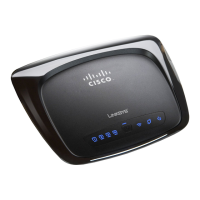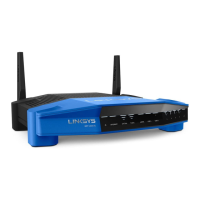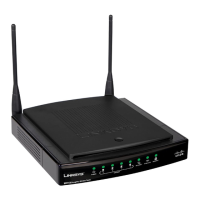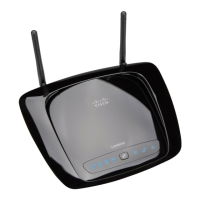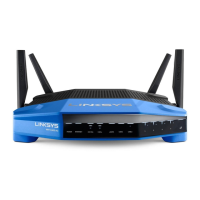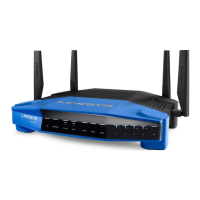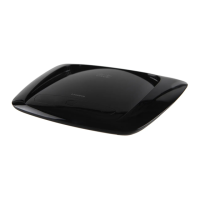Do you have a question about the Linksys WRT120N and is the answer not in the manual?
Explains icons used in the guide for notes, warnings, and web links.
Lists website addresses for Linksys resources like support and glossary.
Details trademarks and copyright information for Linksys and Cisco.
Details the LEDs and buttons on the front of the router.
Describes the ports and buttons on the back of the router.
Instructions on how to place the router horizontally.
Instructions and hardware suggestions for mounting the router on a wall.
Guide to changing the default SSID for better security.
Instructions to change the default admin password for security.
Explains how to enable MAC address filtering for network access control.
Discusses enabling encryption (WPA/WPA2/WEP) for wireless security.
Provides general advice for securing the wireless network.
Offers extra tips for improving wireless network security.
How to access and log into the router's configuration interface.
Configuration of basic router settings like language and internet connection.
Explanation of DHCP for automatic IP address assignment.
How to configure a static IP address for internet connection.
Steps for configuring PPPoE connection for DSL internet.
Configuration for PPTP connections, typically used in Europe.
Configuration for L2TP connections, typically used in Israel.
Configuration for Telstra Cable internet connections in Australia.
Explains optional settings like Host Name and Domain Name.
How to set Host Name and Domain Name for the router.
Configuration of Maximum Transmission Unit for network packets.
Configuration of the router's built-in DHCP server.
How to assign static IP addresses to specific devices using MAC addresses.
Configuration of Dynamic DNS service for remote access.
How to clone a MAC address to avoid ISP registration issues.
Configuration of advanced routing options like NAT and Dynamic Routing.
Explains NAT, Dynamic Routing (RIP), and Static Routing.
Configuration of basic wireless network settings like mode and SSID.
Details Network Mode, Network Name (SSID), and Channel Width.
Explains methods for configuring wireless security using WPS.
Describes three methods for setting up Wi-Fi Protected Setup.
Configuration of wireless security modes like WPA, WPA2, and WEP.
Configuration details for WPA Personal security mode.
Configuration details for WPA2 Personal security mode.
Configuration for WPA Enterprise security with RADIUS server.
Configuration for WEP security with a RADIUS server.
Configuration for WPA2 Enterprise security with RADIUS server.
Configuration details for WEP security mode.
Setting up MAC address filtering for wireless access control.
Displays a list of connected wireless clients.
Advanced tuning options for wireless performance.
Configuration for AP Isolation, Frame Burst, and Authentication Type.
Configuration of SPI Firewall and Internet Filter settings.
Details on Internet Filter and Web Filter options.
Enabling VPN tunnels (IPSec, PPTP, L2TP) through the firewall.
Setting up policies to block or allow internet access by time and type.
How to manage access policies for internet usage.
Overview of created internet access policies.
Configuring port forwarding for specific applications.
Setting up port forwarding for a range of ports.
Details on configuring port forwarding for applications.
Configuring port triggering for specific applications.
Configuring DMZ hosting for exposing a computer to the internet.
Explanation and configuration of DMZ hosting.
Configuring Quality of Service for network traffic prioritization.
Settings for QoS support and No Acknowledgement.
Setting bandwidth priority for devices based on MAC address.
Setting bandwidth priority for online games.
Setting bandwidth priority for specific Ethernet ports.
Setting bandwidth priority for voice devices.
Managing router access and security settings.
Settings for local and remote management access.
Configuring and viewing router logs for traffic monitoring.
Running diagnostic tests like Ping and Traceroute.
Details on performing Ping and Traceroute tests.
Restoring the router to its original factory default settings.
Instructions for upgrading the router's firmware.
Steps to download and install new firmware for the router.
Displays information about the router's current status and settings.
Displays information about the local wired network.
Details on MAC Address, Router IP, and Subnet Mask.
Shows the status of the router's DHCP server function.
Displays information about the wireless network status.
Steps to troubleshoot internet connectivity issues.
Explains requirement for cable/DSL modem, not dial-up.
Router auto-connects to ISP, manual connection not needed.
Router requires a separate DSL modem; telephone line connects to modem.
How to prevent automatic dial-up prompts from the browser.
Router requires a separate cable modem.
Troubleshooting wireless connection issues.
Warnings regarding water and electrical storms.
Compliance information with FCC Part 15 rules.
Compliance with FCC limits for radiation exposure.
Compliance with Canadian ICES-003 and RSS210 standards.
Compliance with IC radiation exposure limits.
Information on actual wireless performance vs. specifications.
EU compliance information for wireless products.
Notes on product usage restrictions, e.g., indoor only.
Standards applied for wireless equipment assessment.
Explanation of the CE mark and notified body.
Lists countries with specific restrictions for the product.
Details on restrictions for 2.4 GHz band usage.
Warning about using unsupported software.
How to access additional technical documentation online.
Information on proper disposal and recycling of electronic equipment.
Environmental information for EU customers regarding WEEE.
Detailed environmental information for EU customers.
More environmental info for EU customers.
Describes software origin and licensing terms for Cisco products.
Information on where to find applicable software licenses.
The primary license agreement for Cisco software.
Limitations on using and distributing the software.
Details on ownership of the software and documentation.
Cisco's policy on links to third-party sites and advertisers.
Cisco's practices for collecting user data for services.
Specific features and license terms for Network Magic.
Licenses for open source and third-party software used.
The GNU General Public License terms for open source software.
Detailed conditions for copying, distributing, and modifying GPL software.
Further conditions for GPL software modifications and distribution.
More terms for GPL distribution, patents, and warranty.
Disclaimer of warranties for the GPL software.
The GNU Lesser General Public License for libraries.
Conditions for copying, distributing, and modifying LGPL software.
More terms for LGPL modifications, executables, and source code.
More terms for LGPL executables and source code distribution.
More terms for LGPL distribution, patents, and warranty.
The OpenSSL license terms for cryptographic software.
License conditions for redistribution and use of OpenSSL software.
License terms for the original SSLeay SSL implementation.
Disclaimer of warranties and liability for SSLeay software.
Explains icons used in the guide for notes, warnings, and web links.
Lists website addresses for Linksys resources like support and glossary.
Details trademarks and copyright information for Linksys and Cisco.
Details the LEDs and buttons on the front of the router.
Describes the ports and buttons on the back of the router.
Instructions on how to place the router horizontally.
Instructions and hardware suggestions for mounting the router on a wall.
Guide to changing the default SSID for better security.
Instructions to change the default admin password for security.
Explains how to enable MAC address filtering for network access control.
Discusses enabling encryption (WPA/WPA2/WEP) for wireless security.
Provides general advice for securing the wireless network.
Offers extra tips for improving wireless network security.
How to access and log into the router's configuration interface.
Configuration of basic router settings like language and internet connection.
Explanation of DHCP for automatic IP address assignment.
How to configure a static IP address for internet connection.
Steps for configuring PPPoE connection for DSL internet.
Configuration for PPTP connections, typically used in Europe.
Configuration for L2TP connections, typically used in Israel.
Configuration for Telstra Cable internet connections in Australia.
Explains optional settings like Host Name and Domain Name.
How to set Host Name and Domain Name for the router.
Configuration of Maximum Transmission Unit for network packets.
Configuration of the router's built-in DHCP server.
How to assign static IP addresses to specific devices using MAC addresses.
Configuration of Dynamic DNS service for remote access.
How to clone a MAC address to avoid ISP registration issues.
Configuration of advanced routing options like NAT and Dynamic Routing.
Explains NAT, Dynamic Routing (RIP), and Static Routing.
Configuration of basic wireless network settings like mode and SSID.
Details Network Mode, Network Name (SSID), and Channel Width.
Explains methods for configuring wireless security using WPS.
Describes three methods for setting up Wi-Fi Protected Setup.
Configuration of wireless security modes like WPA, WPA2, and WEP.
Configuration details for WPA Personal security mode.
Configuration details for WPA2 Personal security mode.
Configuration for WPA Enterprise security with RADIUS server.
Configuration for WEP security with a RADIUS server.
Configuration for WPA2 Enterprise security with RADIUS server.
Configuration details for WEP security mode.
Setting up MAC address filtering for wireless access control.
Displays a list of connected wireless clients.
Advanced tuning options for wireless performance.
Configuration for AP Isolation, Frame Burst, and Authentication Type.
Configuration of SPI Firewall and Internet Filter settings.
Details on Internet Filter and Web Filter options.
Enabling VPN tunnels (IPSec, PPTP, L2TP) through the firewall.
Setting up policies to block or allow internet access by time and type.
How to manage access policies for internet usage.
Overview of created internet access policies.
Configuring port forwarding for specific applications.
Setting up port forwarding for a range of ports.
Details on configuring port forwarding for applications.
Configuring port triggering for specific applications.
Configuring DMZ hosting for exposing a computer to the internet.
Explanation and configuration of DMZ hosting.
Configuring Quality of Service for network traffic prioritization.
Settings for QoS support and No Acknowledgement.
Setting bandwidth priority for devices based on MAC address.
Setting bandwidth priority for online games.
Setting bandwidth priority for specific Ethernet ports.
Setting bandwidth priority for voice devices.
Managing router access and security settings.
Settings for local and remote management access.
Configuring and viewing router logs for traffic monitoring.
Running diagnostic tests like Ping and Traceroute.
Details on performing Ping and Traceroute tests.
Restoring the router to its original factory default settings.
Instructions for upgrading the router's firmware.
Steps to download and install new firmware for the router.
Displays information about the router's current status and settings.
Displays information about the local wired network.
Details on MAC Address, Router IP, and Subnet Mask.
Shows the status of the router's DHCP server function.
Displays information about the wireless network status.
Steps to troubleshoot internet connectivity issues.
Explains requirement for cable/DSL modem, not dial-up.
Router auto-connects to ISP, manual connection not needed.
Router requires a separate DSL modem; telephone line connects to modem.
How to prevent automatic dial-up prompts from the browser.
Router requires a separate cable modem.
Troubleshooting wireless connection issues.
Warnings regarding water and electrical storms.
Compliance information with FCC Part 15 rules.
Compliance with FCC limits for radiation exposure.
Compliance with Canadian ICES-003 and RSS210 standards.
Compliance with IC radiation exposure limits.
Information on actual wireless performance vs. specifications.
EU compliance information for wireless products.
Notes on product usage restrictions, e.g., indoor only.
Standards applied for wireless equipment assessment.
Explanation of the CE mark and notified body.
Lists countries with specific restrictions for the product.
Details on restrictions for 2.4 GHz band usage.
Warning about using unsupported software.
How to access additional technical documentation online.
Information on proper disposal and recycling of electronic equipment.
Environmental information for EU customers regarding WEEE.
Detailed environmental information for EU customers.
More environmental info for EU customers.
Describes software origin and licensing terms for Cisco products.
Information on where to find applicable software licenses.
The primary license agreement for Cisco software.
Limitations on using and distributing the software.
Details on ownership of the software and documentation.
Cisco's policy on links to third-party sites and advertisers.
Cisco's practices for collecting user data for services.
Specific features and license terms for Network Magic.
Licenses for open source and third-party software used.
The GNU General Public License terms for open source software.
Detailed conditions for copying, distributing, and modifying GPL software.
Further conditions for GPL software modifications and distribution.
More terms for GPL distribution, patents, and warranty.
Disclaimer of warranties for the GPL software.
The GNU Lesser General Public License for libraries.
Conditions for copying, distributing, and modifying LGPL software.
More terms for LGPL modifications, executables, and source code.
More terms for LGPL executables and source code distribution.
More terms for LGPL distribution, patents, and warranty.
The OpenSSL license terms for cryptographic software.
License conditions for redistribution and use of OpenSSL software.
License terms for the original SSLeay SSL implementation.
Disclaimer of warranties and liability for SSLeay software.
| xDSL connection | No |
|---|---|
| Dimensions (WxDxH) | 203 x 160 x 35 mm |
| Power requirements | 12 V, 1.0 A |
| Maximum data transfer rate | 0.3 Gbit/s |
| Compatible operating systems | Windows XP, Vista Mac OS X 10.4 + |
| Receiver sensitivity | -94dBm @ 1Mbps -90dBm @ 11Mbps -75dBm @ 54Mbps -66dBm @ 270Mbps |
| Antenna gain level (max) | 2 dBi |
| Reset button | Yes |
| Ethernet LAN (RJ-45) ports | 4 |
| Security algorithms | WEP, WPA2 |
| Certification | FCC, UL/cUL, ICES-003, RSS210, CE, Wi-Fi (IEEE 802.11b/g), WPA, WMM |
| Product color | Black |
| Modulation | 16-QAM, 64-QAM, BPSK, OFDM |
| Storage temperature (T-T) | -20 - 60 °C |
| Operating temperature (T-T) | 0 - 40 °C |
| Storage relative humidity (H-H) | 5 - 90 % |
| Operating relative humidity (H-H) | 10 - 80 % |
| Weight | 238 g |
|---|
